ASUS UX31A: Putting the Ultra in Ultrabooks
by Jarred Walton on August 28, 2012 9:00 AM EST- Posted in
- Laptops
- Intel
- Asus
- Ivy Bridge
- Zenbook Prime
- Ultrabook
ASUS UX31A: Battery Life
Battery life is one of the more important aspects of an Ultrabook, given their focus on mobility. The UX31A doesn’t do quite as well as other Ultrabooks in this aspect, but that appears to be the price of entry for the 1080p display. Even so, battery life isn’t a huge issue, as we’re still in the range of being able to run all day without the need to plug in.
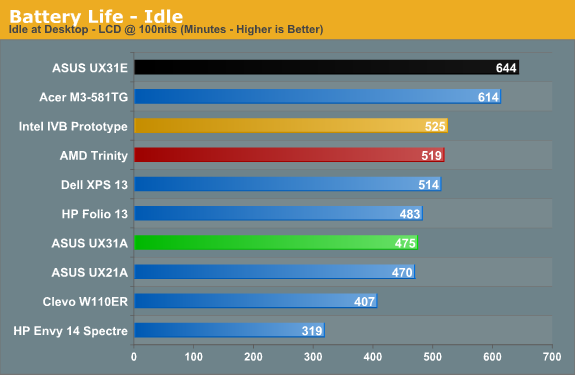
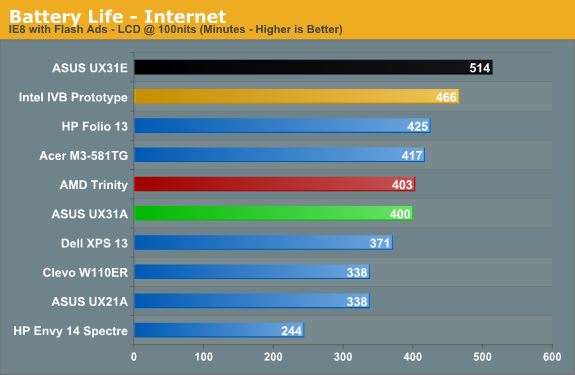
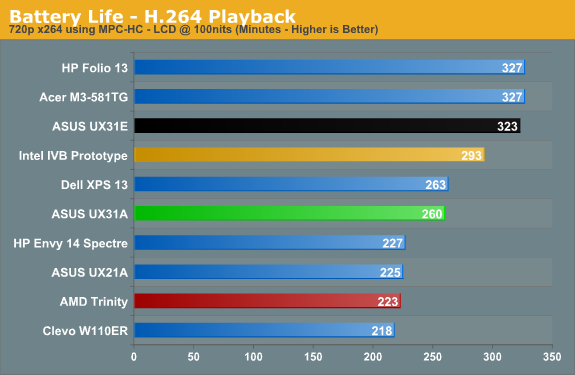
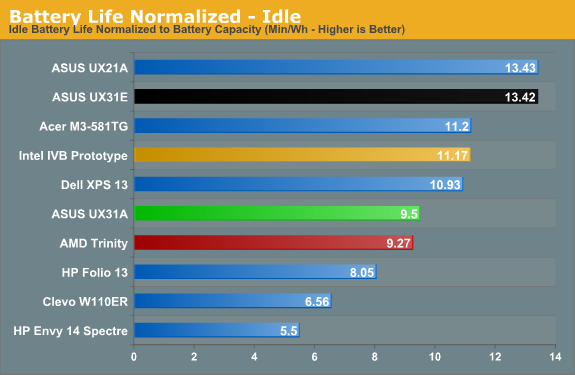
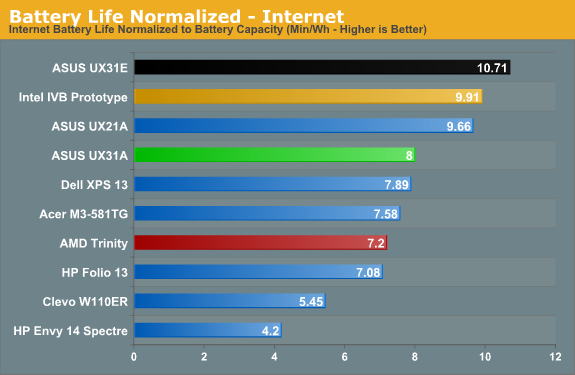

We’ve seen several 13.3” Sandy Bridge Ultrabooks deliver better battery life, while the Ivy Bridge offerings so far appear to cluster together. The prototype Ultrabook did better in all three of our battery tests, but at the same time the UX31A surpasses both the Acer S3 and its little brother the UX21A. In the case of those last two, of course, we’re looking at a 50Wh battery capacity compared to 35Wh, which means when we look at normalized battery life, things aren’t quite so good. Unless you want more than six or so hours of useable battery life, though, the UX31A should be sufficient.
Just make sure to plug the UX31A in at night, as like most laptops it will still require several hours to recharge. Actually, that’s not entirely correct: ASUS has implemented a quick-charge feature where the battery can reach 80% of its maximum in under two hours (110 minutes)—and that’s with the laptop powered up and the LCD at 100% brightness. The final 20% charge will require another 80 minutes or so, which means you’ll need about 3.5 hours of charging to go from a fully drained battery to a 100% charge.
And speaking of running the LCD at 100% brightness, I did a quick test to see how much that would impact battery life in our idle test. This is actually a perfectly valid use case for someone working outside or in a car, and the result is a drop from 475 minutes to 295 minutes. Going with the 50Wh rated capacity of the battery, that means the LCD uses an extra ~3.9W when set to 100% brightness instead 28% (100 nits). That might not seem like much, but keep in mind that at 100 nits the entire laptop consumes around 6.2W, so the LCD can easily account for over a third of the total power draw in light workloads.
Overall, battery life is good if not exceptional. Depending on how bright you want to run the LCD, you can get anywhere from five to eight hours of light use out of the UX31A. We’ve certainly seen better batter life elsewhere, but the loss in raw battery life is a small price to pay for what is, in our experience, the best 13.3” LCD you can currently find in any laptop—Ultrabook or otherwise.


_575px.jpg)








106 Comments
View All Comments
Belard - Tuesday, August 28, 2012 - link
Those issues are typical of ultrabooks... okay, other than the non-standard proprietary SSD connector.For a notebook in this this class, it seems ASUS hits most of the marks. But it also shows their stupidity of using non-standard SSD and the crappy generic keyboard. Only an idiot would have the power button where IT DOESN'T BELONG. It a cheap way of doing things. Otherwise, it looks like a beautiful ultrabook, its brushed metal looks great.
For business users, the ThinkPad X1 Carbon is still better BUT it doesn't have a 1080p screen at this time. I'm guessing within a year or so, 1080p SHOULD be standard but on the sub $600 notebooks.
The keyboard on the ThinkPad is still the best. The screen is matte. The memory (LIKE pretty much ALL UB) is soldered - its a space issue. The X1 comes with 4 or 8GB of RAM. For typical users, 4GB is still more than enough. Still, Ultrabooks are really nothing more than the PC version of the Apple Air, priced and aimed at the high end user, willing to spend an extra $500~1000 on a notebook. People with money do this... but for a typical WORK computer, its idiotic.
Look at the ThinkPad T430s, its just under 4lbs and only 1" thick, its not a wedge shape... its very expandable 4/8/16GB, any kind of drive you want and even includes a dead-weight optical drive. I bet they could shave off 1/2 a pound by ditching the optical drive... but it does have its uses (not needed an external.
And of course, going with a standard 5~6lb notebook means you are paying $500~700 for about the same performance.
Here is an example (as close to possible same spec):
$1600 Ultrabook - Carbon X1 - i7-3667 (3.2Ghz max) 4GB RAM 128GB SSD - 8hr battery
14" screen (1600x900) Mini DP / USB 2 (1) / USB 3 (1) Audio and SD Card reader.
* Oddly, the 8GB version only comes with a slower i5 2.8Ghz CPU for $1680 base.
$1225 SlimBook - T430s - i5-3320M (3.3Ghz max) 4GB RAM 128GB SSD - 7hr battery
14" screen (1600x900) Mini DP / USB 2 (1)Pwr / USB 3 (2) Audio SD Card reader & VGA. Ethernet. * the i5 on this notebook is still faster than the i7 in the ultrabook. ** Option to swap out the DVD-RW drive for 2nd battery or 2nd HD.
$1329 Notebook - T430 (Same specs above, including DVD-RW swap) - Yeah, the price is wonky... when configured to match the 430s, it ends up costing more... but is usually about $200 less than the T430s. A 2nd battery adds upto another 4hrs.
* All above configured with same memory/SSD and WWAN communications / back-lit keyboards.
I'd rather pocket the $400 to forgo the 1lb savings. Get the extra USB port and far easier to expand notebook that will hold ANY 2.5" drive I want to upgrade to later.
Of course, my needs and others aren't the same. I have a 15" and a 12" thinkpads for different uses. Expandability in a .75" form-factor is not allowed with todays tech and I don't find the price to be all that good. Mind you, its better than 3-4 years ago when Lenovo had the X1 ThinkPad which was the FIRST "Apple AIR" like notebook on the market, it too was $2000.
For the usual computer user (mom / web-user - facebook blah) - a $400 6lb 15" notebook or $400 tablet will do just fine. For $330, picked up a semi-bottom end Lenovo with an i3-CPU, 4GB, 320GB HD, 15" 1366x768 screen, almost not crap-ware installed (just the AV program, I think McAffe) - it was more than enough.
Hence, for the PC market, Ultrabooks are for those who want to spend $1000+
bji - Tuesday, August 28, 2012 - link
It probably seems overly picky, but I would never consider the Thinkpad line because of the pointer nub in the middle of the keyboard.That is so 1990s. Yeah I know there are a few stalwart fans who still want a pointer nub, but for everyone else, it's a needless appendage, and it actually interferes with my typing (I don't touch type, I have my typing style which is reasonably fast and accurate but gets tripped by the nub).
Also the screen is 16:9, which I guess is acceptable in the PC world since it's all anyone seems to offer, but I vastly prefer the 16:10 aspect ratio on my retina macbook pro.
Belard - Tuesday, August 28, 2012 - link
I'm okay with the pointy stick... ThinkPad clones by HP & Dell have thrown that in as well. Considering on the latest revised keyboards (which still feel very much the same and allow for back-lighting) - they kept it and it takes up a bit more space than it should. I think it can go... I'm not die hard for it, I still prefer a mouse. My two ThinkPads DO NOT have a touch pad.Also, the current keyboard still has the stupid Fn <> CTRL keys switched. They can be flipped in BIOS (A hint that they SHOULD change the keys). Whatever, the keyboard is still better than the ASUS one above... but not as good as their previous layout style. I would have loved to have seen a mixture of the two. New shape with back-lighting with previous layout and drop the point-stick.
yeah yeah... I hear you on the screen size. Everyone has gone 16:9 which I bloody hate. 16:10 was easily better. Here is an example, a Thinkpad 15" 16:9 we had bought was defective (junky L series) and replaced it with a 14" model 16:10. The 14" screen is just as TALL as the 15". So during that transition, I ordered more 14" models... saved weight and space.
Going 16:9 as a standard has its benefits. Doing video output in 1080 is the same as the notebook (if its 1080) and keeps things from looking strange. Other than that... i hate it. When ever I get a new thinkpad, I'll be stuck getting such a screen.... sigh.
Impulses - Tuesday, August 28, 2012 - link
I've only skimmed the review, I'll be reading it from start to finish later, but I didn't see any mention of the included Ethernet adapter or even the AC charger like on past UX reviews... I assume they're both the same ones we've seen bundled before but not everyone might realize that. I've actually been looking for a GigE USB 3.0 adapter without much luck, probably why ASUS didn't upgrade from the Ethernet one.JarredWalton - Tuesday, August 28, 2012 - link
I added those to the "Extras" section of the table; without GbE, though, it's not much faster than WiFi at best and it's slower in some cases. Large files over the WiFi connection (particularly with 5GHz) can hit 18MB/s, where 100Mb Ethernet maxes out around 12.5MB/s. Lots of smaller files are still much faster over Ethernet, though, due to latency.MadMan007 - Tuesday, August 28, 2012 - link
Proprietary SSD connector = fail.MichaelD - Tuesday, August 28, 2012 - link
Yup. One of the "joys" of laptop ownership for me is the ability to upgrade things down the road. I keep my portable devices for a long time. Even my single-core, 1.2GHz AMD-based laptop is relatively speedy with 2GB of RAM and a hybrid HD in it, for example.janderk - Tuesday, August 28, 2012 - link
Asus got you covered. If buy the slightly thicker UX32VD you can put in it your own SSD and one stick of RAM.Belard - Tuesday, August 28, 2012 - link
Yep, I kind of learned this problem myself with the first ThinkPad T400s, it uses a 1.8" drive form factor, which until recently - was not available for SSD, or at least rarely.Proprietary connector for a standard device = stupid.
GotThumbs - Tuesday, August 28, 2012 - link
Agreed. Add in the fact that the memory so soldered....and with ONLY 4 gigs.While I can see companies seeing the Billions of profits Apple gets with this kind of "one size fits all" approach. It doesn't fly with everyone. Building for the masses seems to be the approach taken here as with Apple. No choices...just take what your given...and like it. Not for me and I'm guessing most readers on this site.
It looks nice but that's as far as it goes IMO.
Pass.